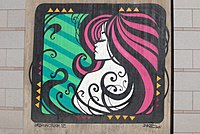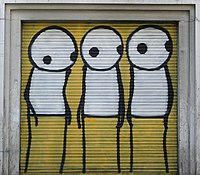Graffiti in the United Kingdom
Since the 1980s, the introduction of hip hop and electro music brought street art to the UK on a large scale.[1] This was further expanded with the introduction of custom may spray paint which allowed artists to create even more artistic and experimental graffiti. Notably, Banksy is arguably one of the most famous graffiti artists in the UK, but it was the crews such as DryBreadZ who first gained recognition.[1] Examples of UK graffiti artists include: Banksy, Stik, Inkie and My Dog Sighs.[2][3]
Graffiti was not considered a credible form of art until the 2000s with the likes of Alex Martinez spreading awareness of this new type of art form. As a result of this art collectors began to get street artists to do commissioned pieces of art for them[1] which lead to graffiti becoming a viable option for street artists to earn some money.
-
Example of Inkie's graffiti
-
Example of Stik's graffiti
-
Example of Banksy's graffiti
-
Example of My Dog Sighs' graffiti
Penalties
When the criminal damage caused by the graffiti exceeds £5,000 the maximum penalty for individuals aged 18 or more is 10 years imprisonment and the maximum penalty for people ages between 12 and 17 is a detention and training order up to 24 months.[4] Alternatively if the damage is less than £5,000 the maximum sentence possible is 3 months imprisonment or a total fine of £2,500 for adults.[4] The Anti-social Behaviour Act 2003 allows police community support officers an alternative remedy by allowing them to issue penalty notices of £50.
An example of this UK punishment is the case of Tom Collister. Collister belonged to a gang of graffiti artists who were carrying out acts of
References
- ^ a b c "The History of Graffiti – Graffiti Comes to the UK | Graff City Ltd". www.graff-city.com. 5 June 2017. Retrieved 21 April 2021.
- ^ Broom, Chris (1 April 2023). "My Dog Sighs - from Free Art Friday, to Inside and international stardom - the Portsmouth street artist celebrates 20 years". Portsmouth News. Retrieved 2 July 2023.
- ^ "History of Street Art in the UK | Widewalls". www.widewalls.ch. Retrieved 21 April 2021.
- ^ a b "Graffiti and the law". www.rbkc.gov.uk. Retrieved 27 April 2021.[permanent dead link]
- ^ a b "PENGE: Tributes paid to hanged prisoner". www.newsshopper.co.uk. 9 February 2009.
- ^ "Four jailed after 'persistent, dedicated' graffiti campaign". 10 October 2008.
- ^ "Rail damage graffiti group jailed". 10 October 2008.
- ^ a b "Tom Collister". 4wardeveruk.orgdate=23 August 2011.
- ^ a b c https://www.bindmans.com/uploads/files/documents/INQUEST_press_release_tom_collister_inquest_verdict.pdf [bare URL PDF]
External links
![]() Media related to Graffiti in the United Kingdom at Wikimedia Commons
Media related to Graffiti in the United Kingdom at Wikimedia Commons




